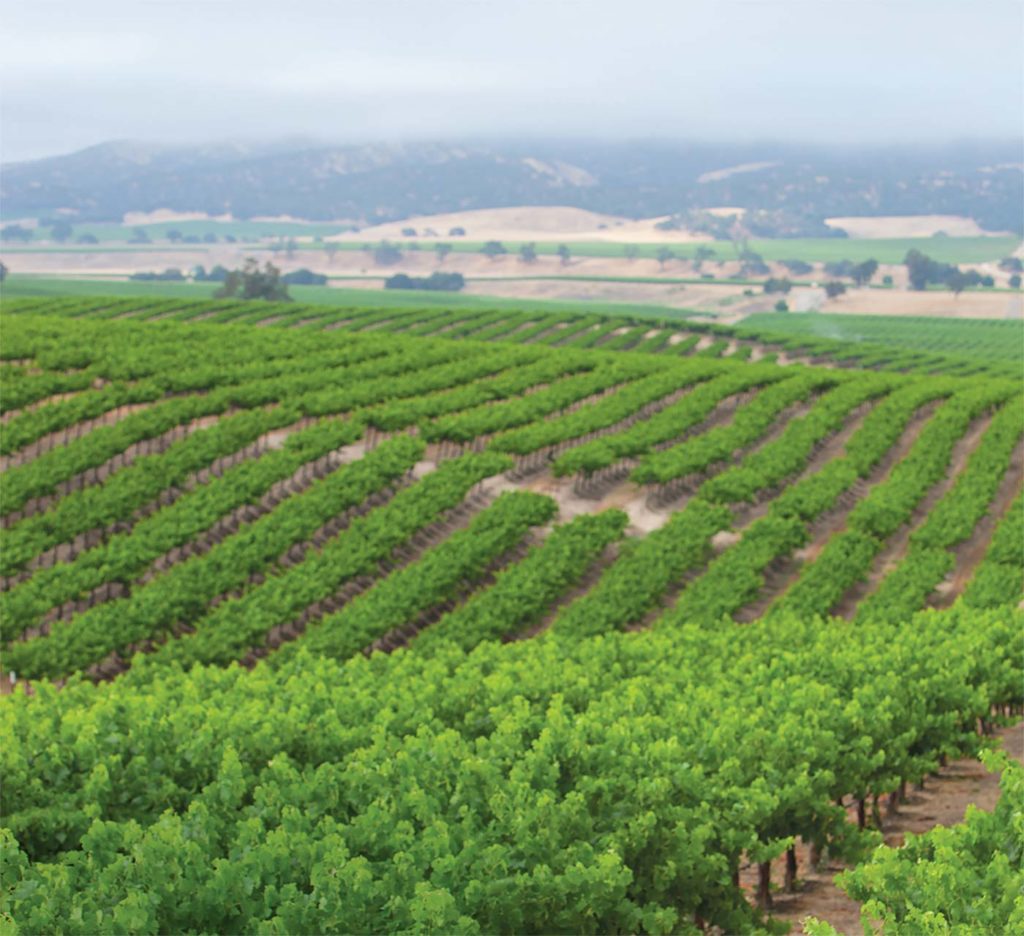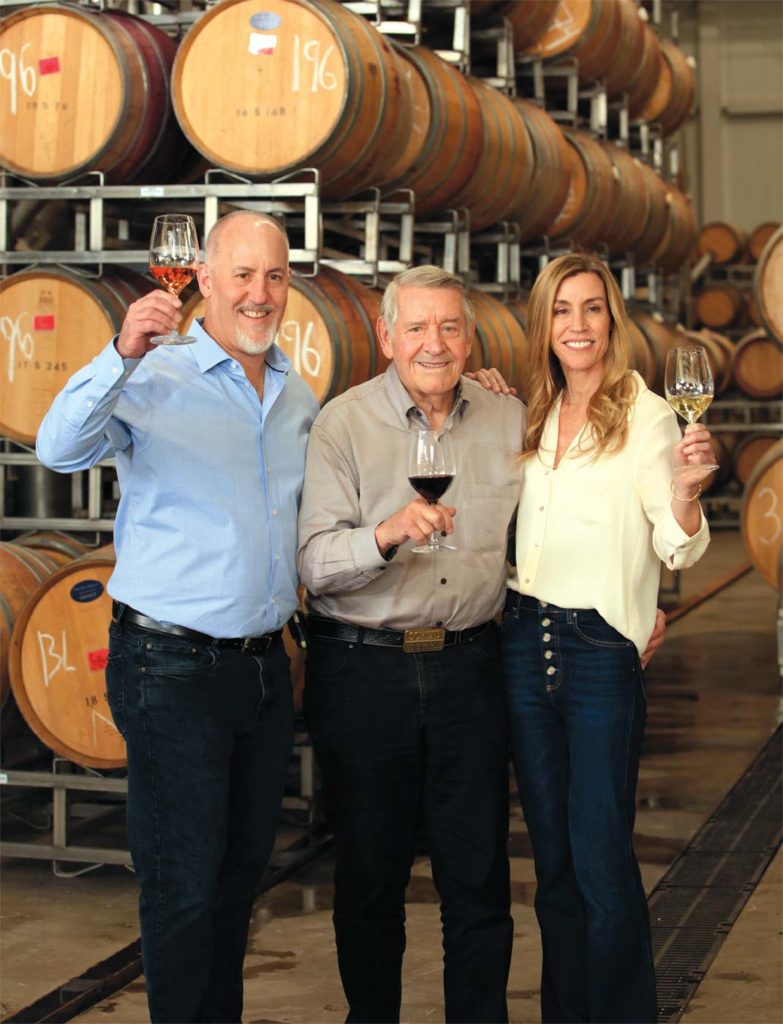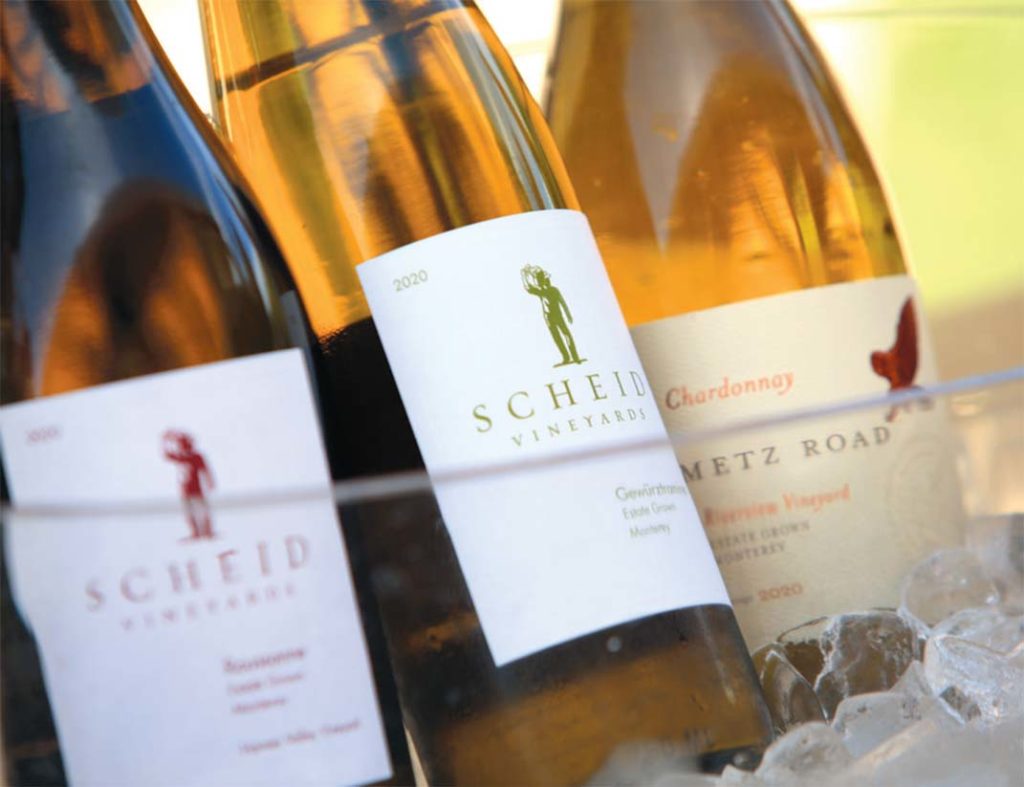PHOTOGRAPHY BY RANDY TUNNELL

Scheid Vineyards toasts to 50th anniversary with growth and wind power
Turning onto Hobson Road from Highway 101 in Greenfield, Scheid is the first property you encounter. It’s also pretty much the only one. The street number is 1972 and that’s no accident. That’s the year patriarch Al Scheid planted the first vines here. When you’ve been on a property as long as the Scheid family has, apparently you can pick any number you want.
Heidi Scheid, executive vice president of Scheid Family Wines, says her father—who turned 90 in February and is now chairman of the board—started the vineyard to make money for his investment partners. “He is always engaging with us, ready to contribute. He also tells us to learn something new every day!” He’s made good on his objective.
From that very first planting, Scheid’s holdings expanded to include more than 3,000 acres of vineyards that stretch the length of the Salinas Valley, covering four different climate zones. “We have estate vineyards in each of them. Riverview and Isabelle’s Vineyard, where we grow pinot noir and chardonnay, are in Region 1,” says Heidi. “Greenfield, Arroyo Seco, is Region 2, where we have pinot noir, chardonnay, sauv blanc and albarino. Further south is Region 3, where the bigger reds are grown: merlot, cabernet sauvignon and syrah, which like the long warm days. In Hames Valley, where there is a huge diurnal temperature difference, 50 to 60 degrees, we grow petite sirah, petite verdot, cabernet sauvignon and tannat.” Quite the portfolio. And it’s all in Monterey County.
For the first 30 years of the operation, Scheid sold 100% of the grapes it grew.
“We were not making any of our own wine,” says Heidi. “In 1989, we made 50 cases. That was the start. In 1997, we opened the Greenfield tasting room. By 2011, we had 4,000 cases of our own wine and decided to focus on growing our own brands.” They also opened what was then the most exciting and posh tasting room on Cannery Row. After a few years, they moved it to a more conducive setting in Carmel, where it thrives with its breadth of offerings.
Scheid has grown to producing more than 700,000 cases of wine annually under various labels, many distributed nationally. It also provides grapes, custom crush and other wine services to a broad range of clients. In 2002, winemaker Dave Nagengast, a Fresno State grad and former discus thrower, came aboard the good ship Scheid. It would never be the same. It is safe to say that he was fundamental in transforming the operation into something massive, yet oh so shipshape.
He was tasked with designing and building a winery that could grow exponentially with the company. The result is a magnificent 85,000-square-foot steel fermentation building, that cost $80 million to build and can accommodate 30,000 tons of grapes, which translates into a capacity to handle more than 2 million cases of wine a year.

As Scheid hits the half-century mark, it has gone from grapes alone to a vertically integrated grape-to-glass operation.

The state-of-the-art winery looks like a scene from Star Wars, gleaming with polished steel and a level of cleanliness you would desire from a facility that handles food. After all, wine is food. The scale of the operation is mind-boggling. It is a marvel of custom machined tanks with special slides for must removal, glistening aluminum gangways, miles of rubber hoses for moving wine, punch down devices and filtering machines, all on wheels, and all designed to scale up as volume grows.
In 2005, Scheid constructed a totally separate 8,000-square-foot microwinery on site to craft the higher-end Scheid Vineyards wines. “This is a winery within a winery that produces the wines we sell in the tasting rooms,” CEO Scott Scheid tells us. “We are planning to build a completely covered and expanded crush pad, complete with ample lighting for those midnight picks.”
As Scheid hits the half-century mark, it has gone from grapes alone to a vertically integrated grape-to-glass operation, inventing new brands yearly to target segments of the market that are not yet filled. That has turned it into a big and complex global company.
Brands like Metz Road, with its succulent chardonnay and pinot noir that are actually made right in the vineyard in a specially designed fermentation trailer, appear on highend restaurant lists. Hive & Honey, a slightly sweet gewürztraminer, is a big seller at Kroger, while District 7 appears on grocery shelves pretty much throughout the Central Coast. Heidi’s current passion is the two-year-old brand called Sunny with a Chance of Flowers, a series of low alcohol, low calorie wines in brilliantly attractive packaging, widely available in retail stores. Keeping its brands fresh, inventive and market ready is part of what fuels Scheid’s success; the other part is a strong commitment to sustainability.
“Sustainability was important to Al from day one,” says Heidi. “He took his role as an environmental steward seriously, as well as giving back to the community. It was critical to become Certified Sustainable, which we have been since 2014. Our 85-acre White Flower Vineyard was certified organic in 2020, and most of our estate vineyards are farmed using organic methods.”

Perhaps the most visible symbol of the company’s commitment to sustainability is the 400-foot tall wind turbine that provides 100% of the power at the facility, generating enough excess energy to power 125 homes in the community. Harnessing the wind has proven a huge win.
As much as Scott loves to talk about the turbine, though, he also enjoys pointing out little bits of history on the property, like the brass replica of a vineyard worker carrying a basket of grapes that graces every Scheid label, by artist Danny Piffero of Mendocino Metals.
“And this fence,” he says, pointing to a wall of tightly spaced slim wooden slats that separates the winery production area from the tasting room and offices, “this is made entirely of the grape stakes we originally used to plant the first vines here. How’s that for recycling?”
Fittingly, the tag line that adorns each wine label and each piece of merchandise remains, “It is the grapes.” As true now as it was back in 1972.
About the author
Laura Ness is a longtime wine journalist, columnist and judge who contributes regularly to Edible Monterey Bay, Spirited, WineOh.Tv, Los Gatos Magazine and Wine Industry Network, and a variety of consumer publications. Her passion is telling stories about the intriguing characters who inhabit the fascinating world of wine and food.
- Laura Nesshttps://www.ediblemontereybay.com/author/lness/
- Laura Nesshttps://www.ediblemontereybay.com/author/lness/
- Laura Nesshttps://www.ediblemontereybay.com/author/lness/
- Laura Nesshttps://www.ediblemontereybay.com/author/lness/


